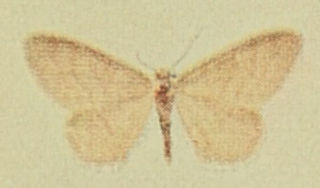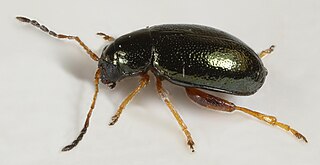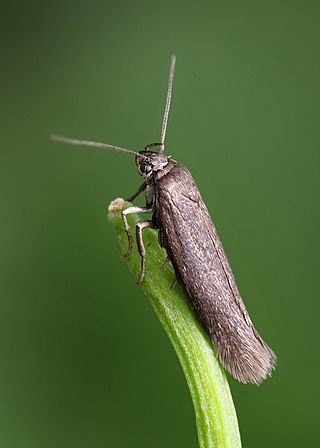
Helianthemum, known as rock rose, sunrose, rushrose, or frostweed, is a genus of about 110 species of flowering plants in the family Cistaceae. They are widely distributed throughout the Northern Hemisphere, especially in the Mediterranean.

The northern brown argus is a butterfly in the family Lycaenidae. It is found throughout much of the Palearctic realm.

Helianthemum nummularium is a species of rock-rose (Cistaceae), native to most of Europe.

Purn Hill is a 6.1 hectare biological Site of Special Scientific Interest near the village of Bleadon, Somerset, notified in 1990. The site is a small promontory of Carboniferous Limestone projecting southward from the main Mendip ridge.

Idaea dilutaria, also called the silky wave, is a moth of the family Geometridae. It is found in Europe.
Parafomoria helianthemella is a moth of the family Nepticulidae. It is found in central and southern Europe, including Germany, south-eastern Poland, the Czech Republic, Slovakia, Hungary, Austria, Switzerland, northern Italy, France and Bulgaria.
Coleophora bilineella is a moth of the family Coleophoridae. It is found in southern Europe.
Coleophora eupreta is a moth of the family Coleophoridae. It is found in France, Spain, Portugal, Italy and North Macedonia.

Coleophora lineolea is a moth of the family Coleophoridae. It is found in most of Europe.

Metriotes lutarea is a moth of the family Coleophoridae. It is found in most of Europe and Turkey.
Adscita capitalis is a moth of the family Zygaenidae. It is found in North Macedonia, Greece and Turkey.

Neotelphusa sequax is a moth of the family Gelechiidae. It is found in most of Europe and has also been recorded from North America.

Mompha miscella is a moth in the family Momphidae, found in Asia Minor, Europe and North Africa.

Aphthona herbigrada is a species of leaf beetles from the subfamily Galerucinae. It is found in Western, Southern and the southern part of Central Europe as well as Algeria. Adult beetles and their larvae feed on leaves of Helianthemum nummularium and Cistaceae species.

Adscita geryon, the cistus forester, is a moth of the family Zygaenidae. It is found in southern and central Europe, east to Turkey. It is also present in Great Britain.
Pyropteron affine is a moth of the family Sesiidae. It is found in most of Europe, except Ireland, Great Britain, the Netherlands, Denmark, Fennoscandia, the Baltic region, Poland and Bulgaria. It is also found in Asia Minor, Georgia, the Middle East and North Africa.

Mesophleps silacella, the straw crest, is a moth of the family Gelechiidae. It is found in Europe, Turkey and Algeria.
Scythris fuscoaenea is a moth of the family Scythrididae found in Europe.

Scythris picaepennis is a moth of the family Scythrididae first described by Adrian Hardy Haworth in 1828. It is found in Europe.
Scythris siccella is a moth of the family Scythrididae first described by the German entomologist Philipp Christoph Zeller in 1839, found in Europe.












